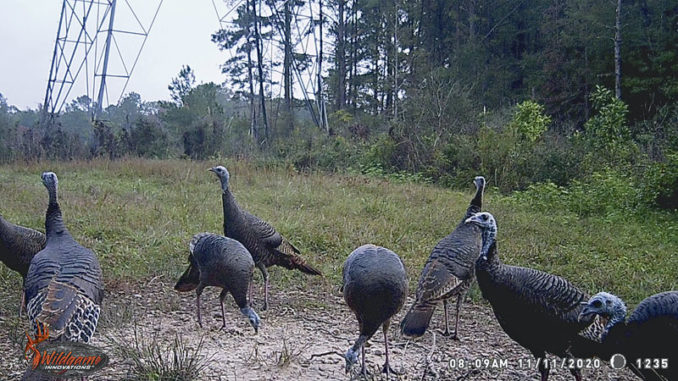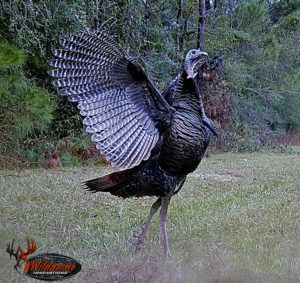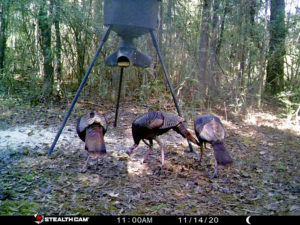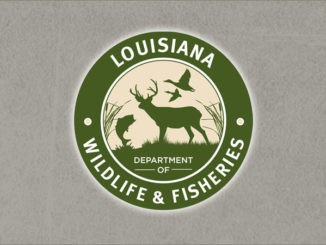
Before turkeys go on the nest, one of the best ways to track gobblers is to keep tabs on the hens
This past deer season, you may have seen groups of turkeys moving around on the land you hunt, if you are blessed to be in an area that has a decent population of turkeys. During the fall and winter, turkeys are rather nomadic, living in separate flocks or groups. Hens normally are together, and the toms are together in separate groups, moving around looking for hard mast on which to feed. With the low acorn crop that we experienced this past year, they may have been making good use of deer corn and food plots. Keep in mind that as spring approaches the flocks will begin to break up before the breeding and nesting season.
The turkey population in my portion of East Feliciana Parish declined dramatically after the extreme flooding of 2016. Consequently, I was excited to see a large group of hens and a small group of adult toms this past deer season. They would appear on the trail cameras a couple of times during the week, and on a few occasions, I actually saw them. However, as deer season closed, they seemed to disappear from the landscape, and now I am wondering if they will be around when the season opens in April.
Turkey hunting is quite challenging, and a 3-year-old gobbler is a very sharp and alert quarry. While 2-year-old toms are often quite responsive and sometimes will run into your lap and say “Shoot me,” older toms are not so easily outwitted.

Reversing nature
In the turkey world, the tom gobbles, and the hen comes to him. In the hunter’s world, the hunter yelps and hopes the gobbler comes to him. Consequently, the hunter is trying to do something that goes against the biology. On one occasion at Pearl River years ago, I had a tom gobbling early one morning, made my setup and chirped back to the gobbling tom. He responded, and I thought it might happen but then, I caught movement to my right, and there came a hen, heading right toward the tom. I sat there and watched it walk out of sight, wondering if maybe I should have spooked it and made it go away, but then, had the hen sounded off with an alarm putt, it would have been over for me anyway.
Observing turkeys as they move around the landscape during turkey season is a great way to learn their habits and movements and may help one connect with a tom. Many will scout before the season and do some calling, but this can make the birds call-shy, more wary and harder to kill. Simply watching the birds and their daily movements will provide insight as to their roosting sites, feeding and nesting areas. With the poor mast crop we experienced this past season turkeys may cover a lot more ground than in the past. It is legal to feed turkeys during the season, you just can’t hunt over the feed or within 200 yards of the area where the feed has been deposited.
Habitat-helping hands
Hunters who have the benefit of hunting on large tracts of land have an edge on hunters who hunt small tracts. Managing the habitat to provide good nesting and brood-rearing habitat may help hunters on small tracts attract hens, and where the hens go, the toms go.
When the season opens toms are generally vocal and have plenty of hens around them. They will move around with the hens, strutting and displaying, trying their best to impress the females. A hunter will often find it difficult to lure a tom away from these live decoys. The tom may come close but then hang up as it waits to see the hen that has been calling. As breeding occurs and hens begin to nest, it will sometimes be easier for the hunter to call in a tom. Consequently, early in the season, simply sitting quietly and watching can often make for success.

Patterning birds
Years ago, I was hunting a small tract of land where the neighbors had an area where they were feeding turkeys. The turkeys would roost on that property and then fly down and head to the corn. After the morning feeding, they would then begin to disperse and move around the landscape. I had a friend who had never killed a turkey coming to hunt, and I was scouting, trying to locate some gobblers. I quickly found that this was their normal pattern: roost off the property, fly down and eat corn for a while, and then begin moving around. Their movements included coming onto the property I was hunting and visiting several of our food plots, generally from noon until roosting time. I watched a group of hens moving on a woods road with a nice gobbler following them. The hens went to plot and then moved through a drain and into another larger plot we had, and then from there would follow the trail back around to the neighbor’s property and then go to roost.
The hunt
A few days later, my friend showed up to hunt. Sure enough, there was plenty of gobbling off the property on the roost and as the birds flew down and went to the corn. We never had any toms near us, so around 11 a.m., I said we might as well go eat lunch and try later. Before leaving, we set up a ground blind off the trail where the turkeys had travelled. We came back around 2 p.m., and I put my friend in the blind. I told him the turkeys would probably come up the trail to this small plot, then head across to roost next door. I went somewhere else if by chance birds were in that area. At 5 p.m. I heard my friend shoot, so I picked up and went to him. A fine adult tom was lying dead on the trail, and he said the tom had come right up the trail as I had predicted.
Sometimes a plan does work out, especially if you keep an eye on the hens.


